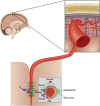Mast cells as early responders in the regulation of acute blood-brain barrier changes after cerebral ischemia and hemorrhage
- PMID: 20087366
- PMCID: PMC2949160
- DOI: 10.1038/jcbfm.2009.282
Mast cells as early responders in the regulation of acute blood-brain barrier changes after cerebral ischemia and hemorrhage
Abstract
The inflammatory response triggered by stroke has been viewed as harmful, focusing on the influx and migration of blood-borne leukocytes, neutrophils, and macrophages. This review hypothesizes that the brain and meninges have their own resident cells that are capable of fast host response, which are well known to mediate immediate reactions such as anaphylaxis, known as mast cells (MCs). We discuss novel research suggesting that by acting rapidly on the cerebral vessels, this cell type has a potentially deleterious role in the very early phase of acute cerebral ischemia and hemorrhage. Mast cells should be recognized as a potent inflammatory cell that, already at the outset of ischemia, is resident within the cerebral microvasculature. By releasing their cytoplasmic granules, which contain a host of vasoactive mediators such as tumor necrosis factor-alpha, histamine, heparin, and proteases, MCs act on the basal membrane, thus promoting blood-brain barrier (BBB) damage, brain edema, prolonged extravasation, and hemorrhage. This makes them a candidate for a new pharmacological target in attempts to even out the inflammatory responses of the neurovascular unit, and to stabilize the BBB after acute stroke.
Figures





Similar articles
-
An emerging role of mast cells in cerebral ischemia and hemorrhage.Ann Med. 2009;41(6):438-50. doi: 10.1080/07853890902887303. Ann Med. 2009. PMID: 19412821 Review.
-
Microvascular endothelial cells-derived microvesicles imply in ischemic stroke by modulating astrocyte and blood brain barrier function and cerebral blood flow.Mol Brain. 2016 Jun 7;9(1):63. doi: 10.1186/s13041-016-0243-1. Mol Brain. 2016. PMID: 27267759 Free PMC article.
-
The Role of Mast Cells in Stroke.Cells. 2019 May 10;8(5):437. doi: 10.3390/cells8050437. Cells. 2019. PMID: 31083342 Free PMC article. Review.
-
Cerebral mast cells regulate early ischemic brain swelling and neutrophil accumulation.J Cereb Blood Flow Metab. 2006 May;26(5):605-12. doi: 10.1038/sj.jcbfm.9600228. J Cereb Blood Flow Metab. 2006. PMID: 16163296
-
Cerebral mast cells mediate blood-brain barrier disruption in acute experimental ischemic stroke through perivascular gelatinase activation.Stroke. 2011 Dec;42(12):3600-5. doi: 10.1161/STROKEAHA.111.632224. Epub 2011 Oct 6. Stroke. 2011. PMID: 21980200
Cited by
-
Age-dependent involvement of gut mast cells and histamine in post-stroke inflammation.J Neuroinflammation. 2020 May 19;17(1):160. doi: 10.1186/s12974-020-01833-1. J Neuroinflammation. 2020. PMID: 32429999 Free PMC article.
-
Mast cells, glia and neuroinflammation: partners in crime?Immunology. 2014 Mar;141(3):314-27. doi: 10.1111/imm.12170. Immunology. 2014. PMID: 24032675 Free PMC article. Review.
-
Stabilization of Brain Mast Cells Alleviates LPS-Induced Neuroinflammation by Inhibiting Microglia Activation.Front Cell Neurosci. 2019 May 3;13:191. doi: 10.3389/fncel.2019.00191. eCollection 2019. Front Cell Neurosci. 2019. PMID: 31130850 Free PMC article.
-
MRI reveals edema in larynx (but not in brain) during anaphylactic hypotension in anesthetized rats.Allergy Asthma Immunol Res. 2013 Nov;5(6):389-96. doi: 10.4168/aair.2013.5.6.389. Epub 2013 Sep 2. Allergy Asthma Immunol Res. 2013. PMID: 24179686 Free PMC article.
-
Sex differences in stroke across the lifespan: The role of T lymphocytes.Neurochem Int. 2017 Jul;107:127-137. doi: 10.1016/j.neuint.2017.01.009. Epub 2017 Jan 25. Neurochem Int. 2017. PMID: 28131898 Free PMC article. Review.
References
-
- Andriopoulou P, Navarro P, Zanetti A, Lampugnani MG, Dejana E. Histamine induces tyrosine phosphorylation of endothelial cell-to-cell adherens junctions. Arterioscler Thromb Vasc Biol. 1999;19:2286–2297. - PubMed
-
- Asahi M, Asahi K, Jung JC, del Zoppo GJ, Fini ME, Lo EH. Role for matrix metalloproteinase 9 after focal cerebral ischemia: effects of gene knockout and enzyme inhibition with BB-94. J Cereb Blood Flow Metab. 2000;20:1681–1689. - PubMed
Publication types
MeSH terms
Substances
LinkOut - more resources
Full Text Sources
Other Literature Sources

